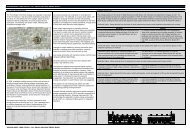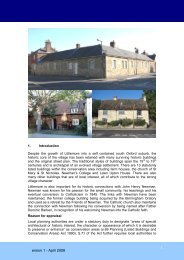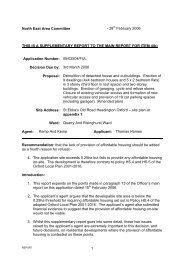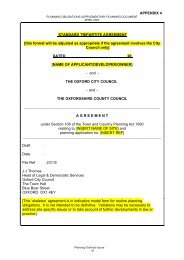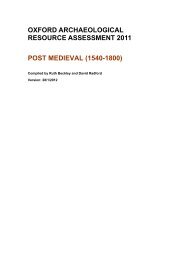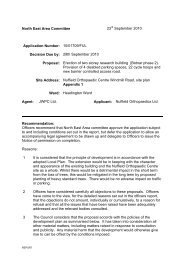Palaeolithic to Mesolithic Oxford (500000 - 4000 BC) - Oxford City ...
Palaeolithic to Mesolithic Oxford (500000 - 4000 BC) - Oxford City ...
Palaeolithic to Mesolithic Oxford (500000 - 4000 BC) - Oxford City ...
You also want an ePaper? Increase the reach of your titles
YUMPU automatically turns print PDFs into web optimized ePapers that Google loves.
Robinson 1993). Within the LAA samples taken during archaeological investigations<br />
at Minchery Farm (Kassam Football Stadium OHER 16787) cover the period from<br />
when the climate was predominately sedges and grasses characteristic of the late<br />
glacial tundra, <strong>to</strong> the present (Parker and Anderson 1996).<br />
As the <strong>Mesolithic</strong> progressed increased woodland provided a dryer climate and<br />
reduced sedimentation (Hey and Roberts 2010). Evidence from peat deposits<br />
discovered during archaeological investigations at St Aldates for example indicated<br />
shallow, standing water during the later <strong>Mesolithic</strong> at about 7200-6900 calibrated<br />
years <strong>BC</strong> (8170±130 BP OxA-4354) (Robinson and Lambrick 1984).<br />
Deposits of peat and tufa (formed through the development of waterlogged ground<br />
where the clays and limes<strong>to</strong>nes meet) can provide environmental evidence for<br />
climate change during the <strong>Palaeolithic</strong> and <strong>Mesolithic</strong>. In the Upper Thames Valley<br />
several ongoing projects carried out by <strong>Oxford</strong> Brookes University and by the<br />
Geological Conservation Review have identified peat and tufa deposits across the<br />
region and have provided environmental sequences from around 10,000 BP <strong>to</strong> the<br />
present (Parker and Anderson 1996: Parker and Goudie 1998; Parker 2000; Day<br />
1990; 1991).<br />
Detailed summaries of two sites within or close <strong>to</strong> <strong>Oxford</strong> have been published; one<br />
outsite the LAA at Sidlings Copse (Day 1990; 1991) covers a period from around ca<br />
9500 yr BP <strong>to</strong> the present and one inside the LAA at Minchery Farm (Parker and<br />
Anderson 1998) from around ca 13,000 yr BP <strong>to</strong> the present. The Minchery Farm<br />
samples indicate the gradual spread of oak, hazel, elm and alder from around ca<br />
10,000 yr BP (ibid.). There areas of shallow water would have gradually become<br />
reedswamp, then marsh before finally becoming woodland (Robinson 2003).<br />
Environmental evidence from sites such as Mingies Ditch and Farmoor indicate a<br />
steady increase in woodland and by the middle of the 6 th millennium <strong>BC</strong>, the region<br />
was likely densely covered by a mixture of deciduous woodland trees (Robinson and<br />
Wilson n.d). For example an organic deposit from a channel of the Windrush at<br />
Minges Ditch produced evidence for dense Alder Woodland dating <strong>to</strong> 5630-5340 cal<br />
<strong>BC</strong> (HAR-8355: 6540+__80BP) (Morigi, Schreve and White 2011: 180). A distinct<br />
decline in woodland is noted in Upper Thames pollen sequences from around ca<br />
5000 yr BP onwards (known as ‘The Elm Decline’) (Parker 2000; Parker et al. 2002).<br />
Evidence for The Elm Decline in the region is often followed by evidence for<br />
agricultural activity in pollen sequences, however the relationship between possible<br />
causes (elm disease, tree clearance for agriculture, climatic change) remain<br />
uncertain (Morigi, Schreve and White 2011: 181-2).<br />
<strong>Mesolithic</strong> artefacts<br />
In has been suggested that <strong>Mesolithic</strong> sites in <strong>Oxford</strong> were primarily located on<br />
sandy geologies such as the Corallian Ridge <strong>to</strong> the east and west of the city (Case<br />
1952-3). At Minchery Farm, Littlemore a small quantity of <strong>Mesolithic</strong> debitage; flakes<br />
with cortex, cores and core rejuvenation flakes indicated that knapping <strong>to</strong>ok place in<br />
the near vicinity (RPS 2001). The recovery of a small amount of late <strong>Mesolithic</strong> or<br />
early Neolithic flintwork at the Manor Ground, London Road, Heading<strong>to</strong>n (Hart 2003)<br />
and at <strong>Oxford</strong> Science Park, Littlemore (Moore 2002: 216) is also consistent with the<br />
documented spread of <strong>Mesolithic</strong> activity from initial sites close <strong>to</strong> the Thames (e.g.<br />
Abingdon) <strong>to</strong> higher ground beyond the immediate environs of the river. Comparable<br />
sites at these higher elevations have been identified at Hatford, Longworth and<br />
Fawler (Case 1986). Elsewhere on the Corallian ridge at Littlemore Hospital a lithic<br />
scatter was discovered comprising of 18 flakes, one axe trimming flake, one crested<br />
blade, one end scraper and one microlith (OHER 16602). Further west a collection of<br />
seven residual flint flakes of likely <strong>Mesolithic</strong> date were recovered during an<br />
OXFORD ARCHAEOLOGICAL RESOURCE ASSESSMENT- PALAEOLITHIC TO<br />
MESOLITHIC 14



